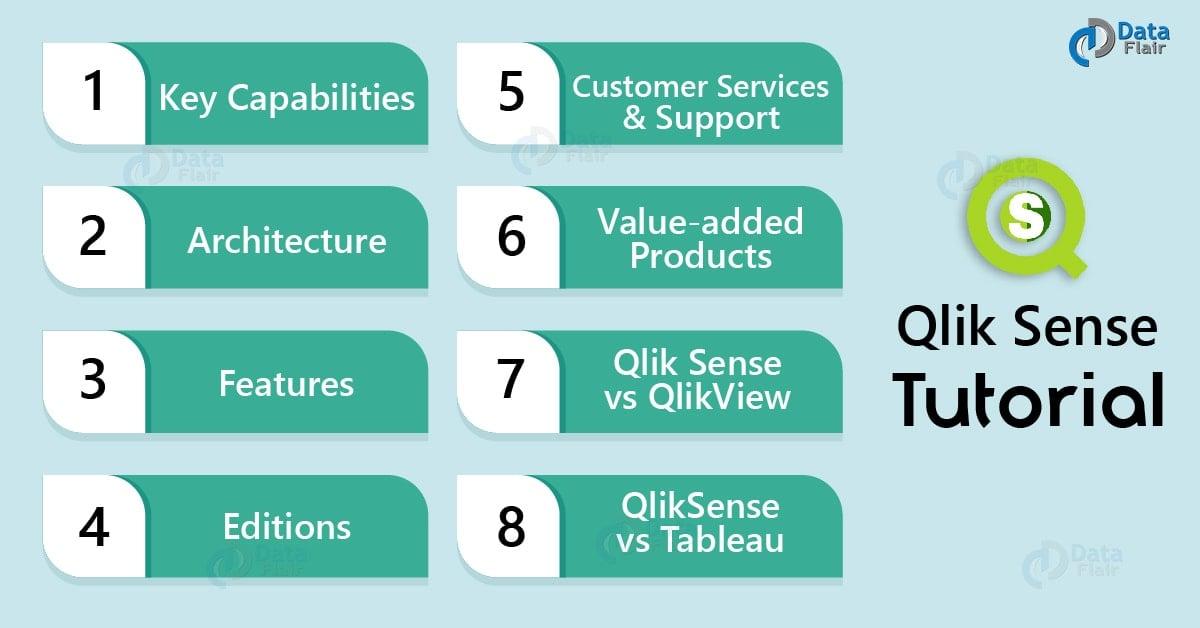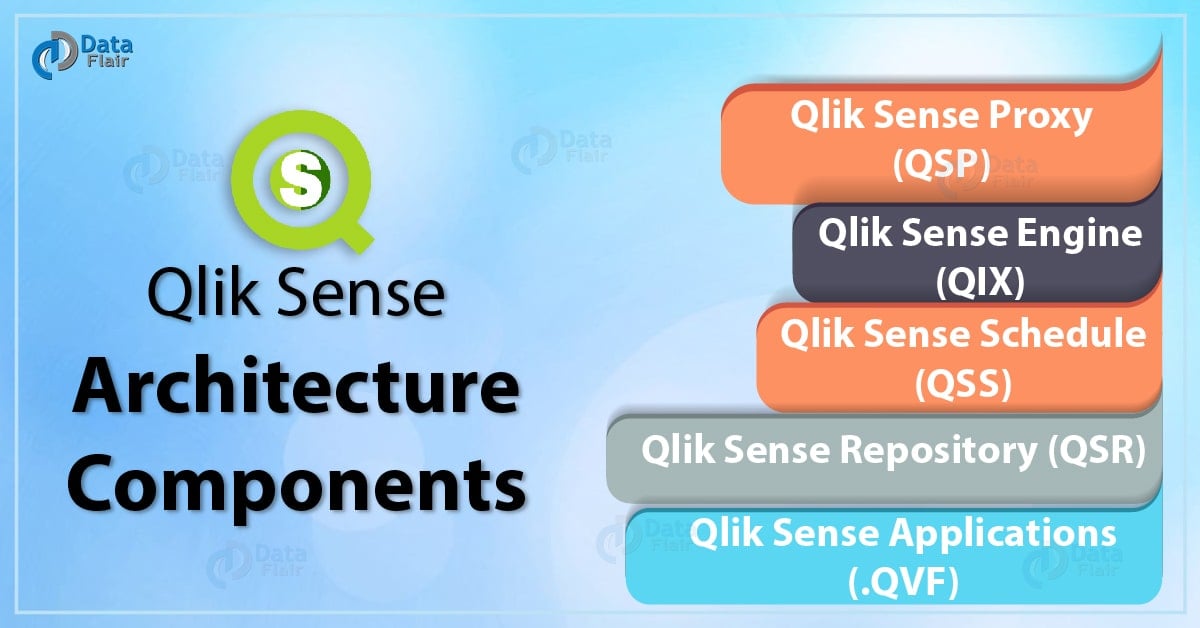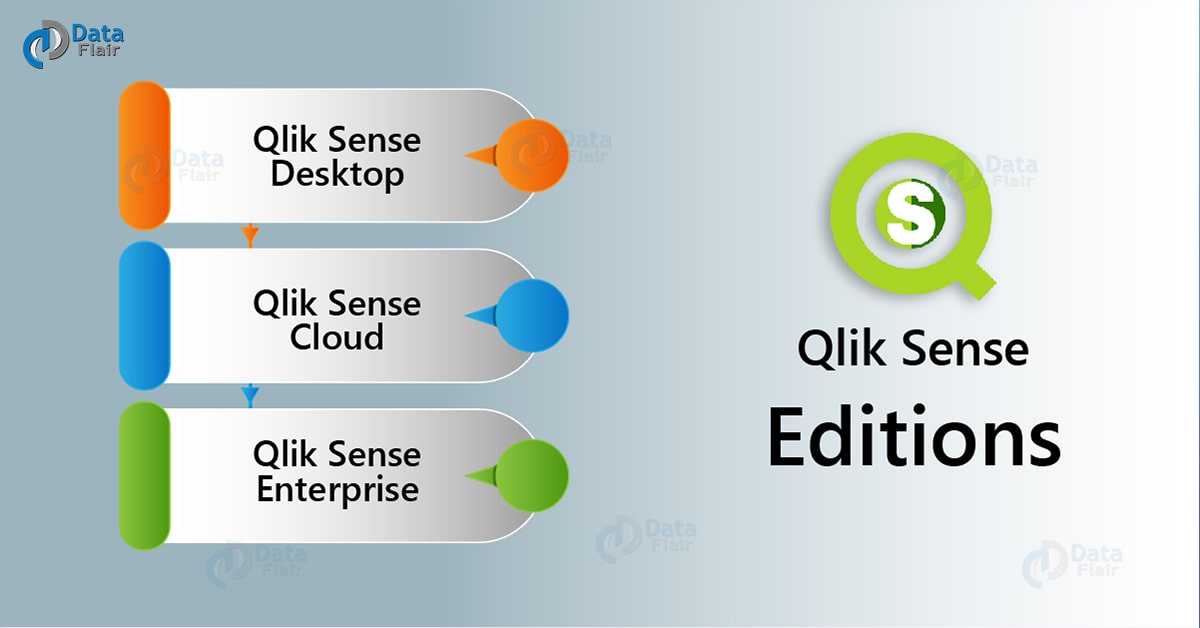Qlik Sense Tutorial For Beginners – Features and Architecture
FREE Online Courses: Dive into Knowledge for Free. Learn More!
1. Objective – Qlik Sense Tutorial
In our quest to learn new data analysis tools we shall learn a very potent tool called Qlik Sense. So, in this QliK Sense Tutorial, we will discuss Qlik Sense architecture, features, and key capabilities. Also, we will look at its editions, value-added products, and customer service. At last, we will see Qlik Sense comparison with QlikView and Tableau.
Qlik Sense emerged in the market of Business Intelligence tools as a new-age technology which offers many user-friendly features. So, it is loaded with advanced data analysis and visualizations services.
So, let’s take the journey into the world of Qlik Sense through this comprehensive Qlik Sense Tutorial with us.
2. What is Qlik Sense?
Qlik Sense is a data analysis and visualization software. It operates with an associative QIX engine which enables the user to link and associate data from varied sources and carries out dynamic searching and selections. Qlik Sense serves as a data analytics platform for a wide range of users i.e. from non-technical to technical users. As opposed to QlikView, Qlik Sense is more about data visualization as it has augmented graphics. Whereas in QlikView, you can manipulate the data in a lot of technical ways through scripting. Nevertheless, if your motive of using Qlik Sense is showing and analyzing data in the best possible graphical ways, then you have made the right choice.
So, Qlik Sense as a tool provides a great deal of flexibility to the users as they can carry out completely independent operations with the self-service visualizations and analysis or be guided by the automated machine-guided analysis by the cognitive engine. As opposed to the traditional query-based model, Qlik Sense used an Associative Model in which users are free to explore the vast and complex labyrinth of data in whichever direction and ways they please to and draw intuitive insights from it. Also, it is possible to integrate large data files from varied sources without any issues. The collaborative properties also aid to the users’ capabilities to draw ingenious inferences from the data. The client team can share data applications and reports on a centralized hub, share secure data models, export the data stories to enhance and flourish the business.
Recommended Reading – Qlik Sense Data Model
3. Qlik Sense Tutorial – Key Capabilities
Given below are some key capabilities of Qlik Sense which we will discuss in detail in another lesson.
- Self-service capabilities
- Augmented visualizations and smart searches/explorations
- Associative model
- Centralized sharing and collaboration
- Hybrid multi-cloud architecture
- Interactive analysis
- Interactive storytelling and reporting
- Mobility and multiple device support
- Big and small data integration
- Enterprise management and scalability
- Robust security
- Geographic and advanced analytics
- Qlik Insight Advisor (AI supported)
- Scalability across on-premise, private, and public cloud environments
4. Qlik Sense Architecture
The architecture of Qlik Sense is designed so that it can provide a scalable, secure and easily manageable work environment to the user. The architecture of Qlik Sense is comprised of a number of components which work in tandem to carry out Qlik Sense services and provide users with visual analytics and data management tools. Before we start with understanding the components of architecture in detail, we must first know two other components which are linked to the architectural components. These two components are the Qlik Sense Hub and Qlik Sense Management Console.
Qlik Sense Hub is the platform where the user performs operations on the data and creates applications with required visualizations. It is the platform where users interact with the software and create dashboards for their business analysis. It provides easy drag-and-drop functionality, associative data model, the range of visualization etc. The viewing of final dashboards is flexible as the screen and it’s contents are automatically adjusted according to the screen size of the device such as a laptop, desktop, tablet, mobile. This hub is developed using HTML5, CSS3, JavaScript etc.
Qlik Sense Management Console is the management platform which lets the administrator centrally manage all the operations taking place in Qlik Sense. The services managed by the management console are,
- Data connectivity
- Application management
- Task management
- Security administration
- Data monitoring
- Auditing
Must Read – Qlik Sense System Requirements
So, let us discuss the architectural components now.
i. Qlik Sense Proxy (QSP)
The QSP serves as the entry point for both users and administrators via sources like hub and management console. The QSP serves many purposes like,
- Session management
- License provisioning
- Handling load balancing
- Connecting with user identity providers like SAML, Active directory etc.
ii. Qlik Sense Engine (QIX)
It is the main interactive/associative engine which facilitates all the major functionalities of Qlik Sense. The functions of QIX are,
- In-memory data indexing and calculations (the engine is RAM-based)
- Smart searching
- Interactive and self-service interactions
- Corresponds with Scheduler, repository, and applications
iii. Qlik Sense Schedule (QSS)
The QSS, as the name suggests, schedules and coordinate the data loads and application reloading.
iv. Qlik Sense Repository (QSR)
The repository is the place where all the data and information regarding the configuration and management of other Qlik Sense services. The main areas of work of QSR are,
Managing user definitions
Security
v. Qlik Sense Applications (.QVF)
This is the final layer where the user uses the data to create visualizations and sheets in Qlik Sense. A Qlik Sense application may have one or more sheets and a complete set of those makes an application or a Qlik Sense .QVF file. Such files contain data in compressed form, a data model pertaining to the data loaded into the Qlik Sense’s in-memory and a final presentation layer.
5. Qlik Sense Features
Given below are the key features of Qlik Sense which are discussed in detail in as a separate article.
- Associative model
- Smart visualization and analytics
- Self-service creation
- Centralized sharing and collaboration
- Data storytelling and reporting
- App Mobility
- Data preparation and integration
- The QIX engine
- Enterprise governance and scalability
6. Qlik Sense Tutorial – Editions
There are three editions of Qlik Sense available in the market.
i. Qlik Sense Desktop
The Qlik Sense Desktop edition is a windows version, which can be locally installed on the system’s desktop. It provides all the important features like local file sharing, visualizing and exploring, data loading and preparation, exporting applications to the cloud, enterprise support, storytelling etc. Although this version is not the full version as it provides limited functionalities as opposed to the enterprise edition. The Desktop version is used on an individual level and is free of cost.
Recommended Reading – Qlik Sense Key Concepts
ii. Qlik Sense Cloud
Qlik Sense Cloud is a cloud deployed edition. Users can create and share applications. They can also share analytics reports in with others. It also provides access to multiple devices. The benefit of cloud edition is expanded storage and unlimited data. There are two types of cloud version; Cloud Basic and Cloud Business version. The Qlik Sense Cloud Business version provides extra functionalities for collaborating group analysis and data governance. The Cloud Basic edition is free of cost service and can be shared between a maximum of 5 users, whereas, the Cloud Business version’s charge is $15 per month and can be shared amongst unlimited users.
iii. Qlik Sense Enterprise
Qlik Sense Enterprise version is the premium or full version specific for enterprise use. It provides a complete set of data analysis features like reporting, visualization, exploration, multi-platform cloud deployment, collaboration, data integration, API for custom analytics, enterprise governance and scalability. Basically, the enterprise edition is sold on the basis of a token model i.e. $1,500 for one token.
7. Qlik Sense Tutorial – Customer Services & Support
Qlik Sense has a wholesome customer support. The support team operates on two levels; on an individual level for customers using the QliK Sense desktop version called Basic Support and on the enterprise level for the Qlik Sense enterprise version called Enterprise Support.
Learn – How to create a Qlik Sense Application
- In the basic support which is operated on a desktop level and mostly for individual users, the users can seek guidance and help through telephone support services, easily available self-help resources and product updates.
- Generally, the enterprise customer support naturally offers more facilities than the basic support. 24×7 technical and proactive support is available along with personal problem solving of critical issues by the engineers and experts at Qlik Sense.
8. Qlik Sense Value-added Products
Qlik Sense can also extend its functionalities by tagging several value-added products with it. Some useful value-added products offered by Qlik is.
a. Qlik Associative Big Data Index
b. Qlik NPrinting
c. Qlik GeoAnalytics
d. Qlik Data Market
e. Qlik Connectors
9. Qlik Sense Tutorial – QlikView and Tableau
As done in every domain, whenever there exists more than one technology in a domain then they become susceptible to comparisons. So, let us have a look at what place does Qlik Sense holds when compared to two of its counterpart technologies QlikView and Tableau which are quite popular BI tools already.
i. Qlik Sense vs QlikView
Upon comparing Qlik Sense with QlikView, the positives to highlight is the self-service nature of Qlik Sense which does not bother the user much and can carry out analytics and data management operations on its own. Although, the user can also make modifications using the data load editor which contains scripts. Such convenience is not provided in QlikView and the user has to be involved and guide the software in every step of analytics.
ii. QlikSense vs Tableau
When we compare Qlik Sense with Tableau, it reveals that even if Tableau is more popular a BI tool and is easy to use, it does not provide a wide range of visualization which Qlik Sense provides. In Qlik Sense, along with the varied types of charts and visualizations available, a lot of customization options for the charts are also given making it a better choice than Tableau.
We recommend you to read – Qlik Sense Gauge Chart
So, this was all in Qlik Sense Tutorial. Hope you like our explanation.
10. Conclusion – Qlik Sense Tutorial
Hence, we saw a complete Qlik Sense Tutorial. Stay with us on our exploration of this new BI tool. We are sure that the introduction must have caught your fancy and got you on the hook. Moreover, we have covered Qlik Sense features, capabilities and comparison with QlikView and Tableau. Also, we saw editions and value-added products of Qlik Sense.
Still, if any queries or suggestions as to what topics would you want us to cover, drop it in the comment section below.
See also –
Qlik Sense Career Opportunities
Did you like this article? If Yes, please give DataFlair 5 Stars on Google





Dears,
Can you please write about Qliksense mashups.
Regards,
Suneetha
Hi Suneetha,
Thanks for referring our Qlik Sense Tutorial for beginners. We are glad you like our article and suggesting us for more topic. Soon, we will publish a tutorial for QlikSense Mashups.
Keep learning and keep exploring DataFlair.
Dears,
can you please write about stacked bar chart and also storytelling in qliksense
Hey Jayasimhareddy,
Thanks for the suggestion, soon we will work on your request. Till, you can refer our Qlik Sense Gauge, Pie, Line, Combo charts from the sidebar.
Keep visiting and keep learning from DataFlair
Good morning Dear.
Thank you very much for helping me learn from Qlik Sense.
Can you write an article on how to create extensions in qlik sense?
Greetings from Chile.
Hello Alen,
We are glad, you like our QlikSense Tutorials. Soon, we will process your request.
Keep Learning Keep Visiting DataFlair